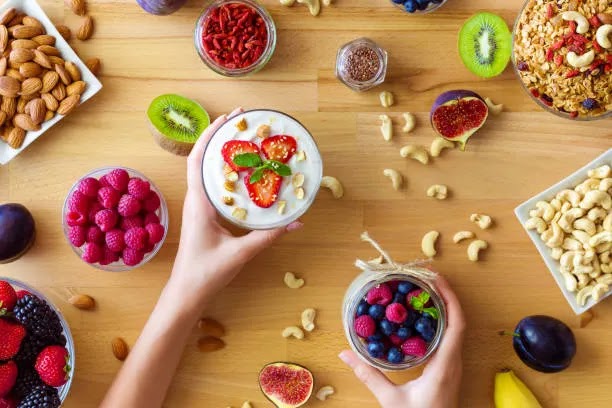With your breakfast bowl, keep your
numbers modest.
Oatmeal is a versatile food that is high in vital nutrients like carbs and fiber and lends itself to various ways. The soluble fiber in oatmeal, which can help lower blood cholesterol levels, is one of the health benefits of eating a daily bowl of oats. This unique type of fiber can reduce cholesterol absorption in the bloodstream, and current research suggests that eating five to ten grams or more of soluble fiber per day can help lower LDL cholesterol, which is the "bad" type of cholesterol that is the most dangerous to your health. While oatmeal's variety is limitless, let's talk about the oatmeal behaviors you should be following to help lower your cholesterol.
1. Sprinkle fruit over your oats.
Some of the benefits of eating a few pieces of fruit every day, such as vitamin and antioxidant content, may be familiar to you, but did you know that fruit also contains fiber? Most fruits have insoluble fiber, which aids in digestive regularity, and some fruits also contain soluble fiber, which lowers cholesterol. Fruits like pears, cherries, apricots, and apples are high in soluble fiber, and they're all easy to toss into a bowl of oats!
Three-quarters of a cup of dry oats has roughly three grams of soluble fiber, and adding a cup of one of these fruits to your bowl will add at least one gram of soluble fiber to your diet. Every gram counts when aiming to get at least 10 grams of soluble fiber each day.
2. Choose liquid alternatives.
While some people prefer their oatmeal made with water, others prefer the richness of oatmeal made with milk. There are a few features to keep in mind when picking milk to help you achieve your cholesterol-lowering goals. If you prefer dairy milk, use 1 percent or skim to keep your cholesterol intake to a minimum. A cup of whole milk has roughly 24 milligrams of cholesterol, a cup of 1% milk has half that, and a cup of skim milk has only 5 milligrams.
You might also use plant-based milk replacements such as soy, almond, or oat milk, with no cholesterol. Oat milk adds an extra gram of soluble fiber per cup, which is a plus; any milk alternative should be checked for added sugar. Many milk substitutes have additional sugar, raising LDL levels in the blood.
3. Eliminate the butter.
A dish of oatmeal with melted butter on top. This butter topper may seem tasty, and it's likely how many of us grew up eating oatmeal (with a teaspoon of brown sugar), but it can help you achieve your health objectives. About 30 milligrams of cholesterol are included in one tablespoon of butter.
While this may not seem like much, experts recommend taking no more than 300 milligrams of cholesterol each day, and even less may be healthier for those who already have high cholesterol. As a result, a tablespoon of butter and whole milk in your oatmeal may have more than 50 milligrams of cholesterol.
Instead of butter, choose a healthy fat source for your oats. Nut butter, such as almond or peanut butter, is a tasty alternative high in heart-healthy fats. Try topping your oats with a couple of slices of avocado if you enjoy savory porridge.
4. Replace the sugar with anything else.
Remember the brown sugar I mentioned earlier? It might be time to replace it with something healthier. Sugar-rich diets cause your body to produce more "bad" LDL cholesterol and lower "good" HDL cholesterol levels. While a couple of tablespoons of sugar may not seem like much, the average American consumes 77 grams of sugar per day, more than three times the daily limit for women.
Sugar consumption should be reduced wherever possible. Rather than sprinkling sugar on top of your oats, use your fruit topper as a sweet addition to your bowl. A couple of tablespoons of no-sugar-added applesauce may do the trick without raising your cholesterol levels if it doesn't satisfy your sweet tooth.
If neither of those options appeals to you, reduce the sugar, you consume. Before giving up on the lower-sugar oats, try lowering your sugar consumption in half and giving your taste buds some time to adjust. Sugar alternatives such as stevia and monk fruit may also be viable options.
5. Toss in some seeds.
Flax, chia, and hemp seeds are all excellent toppings for porridge. These seed selections are high in fiber, with soluble fiber included in each. Seeds can offer almost five grams of soluble fiber to a single bowl of oatmeal when coupled with the soluble fiber in your oats and fruit.
Each of these seeds has heart-healthy omega-3 lipids that may help lower blood lipid levels and fiber advantages. Furthermore, each serving of these seeds has a few grams of protein, a nutrient that should be included every morning. While chia and hemp seeds are easily digested and absorbed, ground flax will help your body absorb most of its nutrients.
As you can see, there are many ways
to prepare a heart-healthy bowl of oats that can aid in cholesterol reduction.
All you need to get the most out of your oats is a little imagination and a few
more ingredients.

